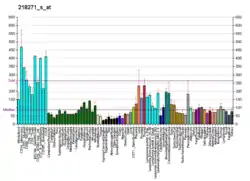PARL
Presenilins-associated rhomboid-like protein, mitochondrial also known as mitochondrial intramembrane cleaving protease PARL is an inner mitochondrial membrane protein that in humans is encoded by the PARL gene on chromosome 3.[4] It is a member of the rhomboid family of intramembrane serine proteases.[5] This protein is involved in signal transduction and apoptosis, as well as neurodegenerative diseases and type 2 diabetes.[4][6]
Structure
Rhomboid family members share a conserved core of six transmembrane helices (TMHs), with the Ser and His residues required to form the catalytic dyad embedded in TMH-4 and TMH-6, respectively. This dyad is found deep below the membrane surface, which indicates that the hydrolysis of peptide bonds occurs within the hydrophobic phospholipid bilayer membrane. As a member of the Parl subfamily, PARL has an additional N-terminal TMH which may form a loop to the catalytic core. [7]
Function
This gene encodes a mitochondrial integral membrane protein. Following proteolytic processing of this protein, a small peptide (P-beta) is formed and translocated to the nucleus. This gene may be involved in signal transduction via regulated intramembrane proteolysis of membrane-tethered precursor proteins. Variation in this gene has been associated with increased risk for type 2 diabetes. Alternative splicing results in multiple transcript variants encoding different isoforms.[4]
Additionally, PARL is involved in apoptosis through its interactions with the mitochondrial GTPase optic atrophy 1 (OPA1) and the Bcl-2 family-related protein HAX1. OPA1 mainly regulates mitochondrial fusion in the mitochondrial inner membrane, but after proteolytic cleavage by PARL, its short, soluble form contributes to inhibiting apoptosis by slowing down cytochrome c release, and thus, proapoptotic signaling. Alternatively, PARL can inhibit apoptosis by coordinating with HAX1 to activate HtrA2 protease, thus preventing the accumulation of the proapoptotic Bax.[6]
Clinical significance
It has been shown that the p.S77N presenilin-associated rhomboid-like protein mutation is not a frequent cause of early-onset Parkinson's disease.[8] Variation in presenilins-associated rhomboid-like protein (PSARL) sequence and/or expression may be an important new risk factor for type 2 diabetes and other components of the metabolic syndrome.[9] Mutations in PARL may also be involved in Leber hereditary optic neuropathy by disrupting normal function of the mitochondria, thus promoting retinal ganglion cell death and neurodegeneration.[6]
References
- GRCm38: Ensembl release 89: ENSMUSG00000033918 - Ensembl, May 2017
- "Human PubMed Reference:". National Center for Biotechnology Information, U.S. National Library of Medicine.
- "Mouse PubMed Reference:". National Center for Biotechnology Information, U.S. National Library of Medicine.
- "Entrez Gene: PARL presenilin associated, rhomboid-like".
- G. A. McQuibban, S. Saurya, M. Freeman, Nature 423, 537 (2003)
- Phasukkijwatana N, Kunhapan B, Stankovich J, Chuenkongkaew WL, Thomson R, Thornton T, Bahlo M, Mushiroda T, Nakamura Y, Mahasirimongkol S, Tun AW, Srisawat C, Limwongse C, Peerapittayamongkol C, Sura T, Suthammarak W, Lertrit P (Jul 2010). "Genome-wide linkage scan and association study of PARL to the expression of LHON families in Thailand". Human Genetics. 128 (1): 39–49. doi:10.1007/s00439-010-0821-8. PMID 20407791. S2CID 394164.
- Pellegrini L, Scorrano L (Jul 2007). "A cut short to death: Parl and Opa1 in the regulation of mitochondrial morphology and apoptosis". Cell Death and Differentiation. 14 (7): 1275–84. doi:10.1038/sj.cdd.4402145. PMID 17464328.
- Heinitz S, Klein C, Djarmati A (Nov 2011). "The p.S77N presenilin-associated rhomboid-like protein mutation is not a frequent cause of early-onset Parkinson's disease". Movement Disorders. 26 (13): 2441–2. doi:10.1002/mds.23889. PMID 21953724.
- Walder K, Kerr-Bayles L, Civitarese A, Jowett J, Curran J, Elliott K, Trevaskis J, Bishara N, Zimmet P, Mandarino L, Ravussin E, Blangero J, Kissebah A, Collier GR (Mar 2005). "The mitochondrial rhomboid protease PSARL is a new candidate gene for type 2 diabetes". Diabetologia. 48 (3): 459–68. doi:10.1007/s00125-005-1675-9. PMID 15729572.
- Shi G, Lee JR, Grimes DA, Racacho L, Ye D, Yang H, Ross OA, Farrer M, McQuibban GA, Bulman DE (May 2011). "Functional alteration of PARL contributes to mitochondrial dysregulation in Parkinson's disease". Human Molecular Genetics. 20 (10): 1966–74. doi:10.1093/hmg/ddr077. PMID 21355049.
Further reading
- Jeyaraju DV, Xu L, Letellier MC, Bandaru S, Zunino R, Berg EA, McBride HM, Pellegrini L (Dec 2006). "Phosphorylation and cleavage of presenilin-associated rhomboid-like protein (PARL) promotes changes in mitochondrial morphology". Proceedings of the National Academy of Sciences of the United States of America. 103 (49): 18562–7. Bibcode:2006PNAS..10318562J. doi:10.1073/pnas.0604983103. PMC 1693702. PMID 17116872.
- Fawcett KA, Wareham NJ, Luan J, Syddall H, Cooper C, O'Rahilly S, Day IN, Sandhu MS, Barroso I (Nov 2006). "PARL Leu262Val is not associated with fasting insulin levels in UK populations". Diabetologia. 49 (11): 2649–52. doi:10.1007/s00125-006-0443-9. PMC 2672784. PMID 17019603.
- Walder K, Kerr-Bayles L, Civitarese A, Jowett J, Curran J, Elliott K, Trevaskis J, Bishara N, Zimmet P, Mandarino L, Ravussin E, Blangero J, Kissebah A, Collier GR (Mar 2005). "The mitochondrial rhomboid protease PSARL is a new candidate gene for type 2 diabetes". Diabetologia. 48 (3): 459–68. doi:10.1007/s00125-005-1675-9. PMID 15729572.
- Sík A, Passer BJ, Koonin EV, Pellegrini L (Apr 2004). "Self-regulated cleavage of the mitochondrial intramembrane-cleaving protease PARL yields Pbeta, a nuclear-targeted peptide". The Journal of Biological Chemistry. 279 (15): 15323–9. doi:10.1074/jbc.M313756200. PMID 14732705.
- McQuibban GA, Saurya S, Freeman M (May 2003). "Mitochondrial membrane remodelling regulated by a conserved rhomboid protease". Nature. 423 (6939): 537–41. Bibcode:2003Natur.423..537M. doi:10.1038/nature01633. PMID 12774122. S2CID 4398146.
- Pellegrini L, Passer BJ, Canelles M, Lefterov I, Ganjei JK, Fowlkes BJ, Koonin EV, D'Adamio L (Apr 2001). "PAMP and PARL, two novel putative metalloproteases interacting with the COOH-terminus of Presenilin-1 and -2". Journal of Alzheimer's Disease. 3 (2): 181–190. doi:10.3233/jad-2001-3203. PMID 12214059.


